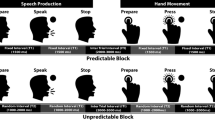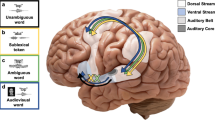Abstract
The predictive coding model suggests that neural processing of sensory information is facilitated for temporally-predictable stimuli. This study investigated how temporal processing of visually-presented sensory cues modulates movement reaction time and neural activities in speech and hand motor systems. Event-related potentials (ERPs) were recorded in 13 subjects while they were visually-cued to prepare to produce a steady vocalization of a vowel sound or press a button in a randomized order, and to initiate the cued movement following the onset of a go signal on the screen. Experiment was conducted in two counterbalanced blocks in which the time interval between visual cue and go signal was temporally-predictable (fixed delay at 1000 ms) or unpredictable (variable between 1000 and 2000 ms). Results of the behavioral response analysis indicated that movement reaction time was significantly decreased for temporally-predictable stimuli in both speech and hand modalities. We identified premotor ERP activities with a left-lateralized parietal distribution for hand and a frontocentral distribution for speech that were significantly suppressed in response to temporally-predictable compared with unpredictable stimuli. The premotor ERPs were elicited approximately −100 ms before movement and were significantly correlated with speech and hand motor reaction times only in response to temporally-predictable stimuli. These findings suggest that the motor system establishes a predictive code to facilitate movement in response to temporally-predictable sensory stimuli. Our data suggest that the premotor ERP activities are robust neurophysiological biomarkers of such predictive coding mechanisms. These findings provide novel insights into the temporal processing mechanisms of speech and hand motor systems.







Similar content being viewed by others
References
Alegre M, Gurtubay IG, Labarga A, Iriarte J, Malanda A, Artieda J (2003) Alpha and beta oscillatory changes during stimulus-induced movement paradigms: effect of stimulus predictability. Neuroreport 14:381–385
Aliu SO, Houde JF, Nagarajan SS (2009) Motor-induced suppression of the auditory cortex. J Cogn Neurosci 21:791–802
Baker KS, Piriyapunyaporn T, Cunnington R (2012) Neural activity in readiness for incidental and explicitly timed actions. Neuropsychologia 50:715–722
Bard C, Paillard J, Lajoie Y, Fleury M, Teasdale N, Forget R, Lamarre Y (1992) Role of afferent information in the timing of motor commands: a comparative study with a deafferented patient. Neuropsychologia 30:201–206
Behroozmand R, Larson CR (2011) Error-dependent modulation of speech-induced auditory suppression for pitch-shifted voice feedback. BMC Neurosci 12:1
Behroozmand R, Liu H, Larson CR (2011) Time-dependent neural processing of auditory feedback during voice pitch error detection. J Cogn Neurosci 23:1205–1217
Behroozmand R, Oya H, Nourski KV et al (2016a) Neural correlates of vocal production and motor control in human Heschl’s Gyrus. J Neurosci 36:2302–2315
Behroozmand R, Sangtian S, Korzyukov O, Larson CR (2016b) A temporal predictive code for voice motor control: evidence from ERP and behavioral responses to pitch-shifted auditory feedback. Brain Res 1636:1–12
Bertelson P, Boons J-P (1960) Time uncertainty and choice reaction time. Nature 187:531–532
Bevan W, Hardesty DL, Avant LL (1965) Response latency with constant and variable interval schedules. Percept Mot Skills 20:969–972
Blakemore S-J, Sirigu A (2003) Action prediction in the cerebellum and in the parietal lobe. Exp Brain Res 153:239–245
Blakemore S-J, Wolpert DM, Frith CD (1998) Central cancellation of self-produced tickle sensation. Nat Neurosci 1:635–640
Blakemore S-J, Wolpert D, Frith C (2000) Why can’t you tickle yourself? Neuroreport 11:R11–R16
Bloxham C, Mindel T, Frith C (1984) Initiation and execution of predictable and unpredictable movements in Parkinson’s disease. Brain 107:371–384
Bloxham CA, Dick DJ, Moore M (1987) Reaction-times and attention in Parkinsons-disease. J Neurol Neurosurg Psychiatry 50:1178–1183. doi:10.1136/jnnp.50.9.1178
Chang EF, Niziolek CA, Knight RT, Nagarajan SS, Houde JF (2013) Human cortical sensorimotor network underlying feedback control of vocal pitch. Proc National Acad Sci 110:2653–2658
Chen Z, Chen X, Liu P, Huang D, Liu H (2012) Effect of temporal predictability on the neural processing of self-triggered auditory stimulation during vocalization. BMC Neurosci 13:1
Conradi N, Abel C, Frisch S, Kell CA, Kaiser J, Schmidt-Kassow M (2016) Actively but not passively synchronized motor activity amplifies predictive timing. NeuroImage 139:211–217
Cornella M, Leung S, Grimm S, Escera C (2012) Detection of simple and pattern regularity violations occurs at different levels of the auditory hierarchy. PLoS One 7:e43604
Coull JT, Cotti J, Vidal F (2016) Differential roles for parietal and frontal cortices in fixed versus evolving temporal expectations: dissociating prior from posterior temporal probabilities with fMRI. NeuroImage 141:40–51
Crowe DA, Zarco W, Bartolo R, Merchant H (2014) Dynamic representation of the temporal and sequential structure of rhythmic movements in the primate medial premotor cortex. J Neurosci 34:11972–11983
Delorme A, Makeig S (2004) EEGLAB: an open source toolbox for analysis of single-trial EEG dynamics including independent component analysis. J Neurosci Methods 134:9–21
Dieterich R, Endrass T, Kathmann N (2016) Uncertainty is associated with increased selective attention and sustained stimulus processing. Cogn Affect Behav Neurosci 16:447–456
Drazin D (1961) Effects of foreperiod, foreperiod variability, and probability of stimulus occurrence on simple reaction time. J Exp Psychol 62:43
Erdfelder E, Faul F, Buchner A (1996) GPOWER: a general power analysis program. Behavior Res Methods Instrum Comput 28:1–11
Faul F, Erdfelder E (1992) GPOWER: A priori, post-hoc, and compromise power analyses for MS-DOS [Computer program]. Bonn University, Department of Psychology, Bonn
Flanagan JR, Vetter P, Johansson RS, Wolpert DM (2003) Prediction precedes control in motor learning. Curr Biol 13:146–150
Gajewski PD, Falkenstein M (2013) Effects of task complexity on ERP components in Go/Nogo tasks. Int J Psychophysiol 87:273–278
Guenther FH, Ghosh SS, Tourville JA (2006) Neural modeling and imaging of the cortical interactions underlying syllable production. Brain Lang 96:280–301
Heinks-Maldonado TH, Mathalon DH, Gray M, Ford JM (2005) Fine-tuning of auditory cortex during speech production. Psychophysiology 42:180–190
Hickok G, Poeppel D (2004) Dorsal and ventral streams: a framework for understanding aspects of the functional anatomy of language. Cognition 92:67–99
Hickok G, Poeppel D (2007) The cortical organization of speech processing. Nat Rev Neurosci 8:393–402
Houde JF, Nagarajan SS (2011) Speech production as state feedback control. Front Hum Neurosci 5:82
Houde JF, Nagarajan SS, Sekihara K, Merzenich MM (2002) Modulation of the auditory cortex during speech: an MEG study. J Cogn Neurosci 14:1125–1138
Hsu M, Bhatt M, Adolphs R, Tranel D, Camerer CF (2005) Neural systems responding to degrees of uncertainty in human decision-making. Science 310:1680–1683
Ivry RB, Keele SW (1989) Timing functions of the cerebellum. J Cogn Neurosci 1:136–152
Jahanshahi M, Jones CR, Dirnberger G, Frith CD (2006) The substantia nigra pars compacta and temporal processing. J Neurosci 26:12266–12273
Johansson R, Westling G (1988) Coordinated isometric muscle commands adequately and erroneously programmed for the weight during lifting task with precision grip. Exp Brain Res 71:59–71
Karlin L (1959) Reaction time as a function of foreperiod duration and variability. J Exp Psychol 58:185
Klemmer ET (1956) Time uncertainty in simple reaction time. J Exp Psychol 51:179
Kotz SA, Schmidt-Kassow M (2015) Basal ganglia contribution to rule expectancy and temporal predictability in speech. Cortex 68:48–60
Kühn AA, Williams D, Kupsch A et al (2004) Event-related beta desynchronization in human subthalamic nucleus correlates with motor performance. Brain 127:735–746
Lakens D (2013) Calculating and reporting effect sizes to facilitate cumulative science: a practical primer for t-tests and ANOVAs. Front Psychol 4:863
Ma H-i, Trombly CA (2004) Effects of task complexity on reaction time and movement kinematics in elderly people. Am J Occup Ther 58:150–158
Mattes S, Ulrich R (1997) Response force is sensitive to the temporal uncertainty of response stimuli. Percept Psychophys 59:1089–1097
Mendoza G, Merchant H (2014) Motor system evolution and the emergence of high cognitive functions. Prog Neurobiol 122:73–93. doi:10.1016/j.pneurobio.2014.09.001
Merchant H, Pérez O, Zarco W, Gámez J (2013) Interval tuning in the primate medial premotor cortex as a general timing mechanism. J Neurosci 33:9082–9096
Merchant H, Pérez O, Bartolo R et al (2015) Sensorimotor neural dynamics during isochronous tapping in the medial premotor cortex of the macaque. Eur J Neurosci 41:586–602
Miall RC, Wolpert DM (1996) Forward models for physiological motor control. Neural Netw 9:1265–1279
Mifsud NG, Oestreich LK, Jack BN, Ford JM, Roach BJ, Mathalon DH, Whitford TJ (2016) Self-initiated actions result in suppressed auditory but amplified visual evoked components in healthy participants. Psychophysiology 53:723–732
Moberget T, Karns CM, Deouell LY, Lindgren M, Knight RT, Ivry RB (2008) Detecting violations of sensory expectancies following cerebellar degeneration: a mismatch negativity study. Neuropsychologia 46:2569–2579
Näätänen R, Paavilainen P, Rinne T, Alho K (2007) The mismatch negativity (MMN) in basic research of central auditory processing: a review. Clin Neurophysiol 118:2544–2590
Niemi P, Naatanen R (1981) Foreperiod and simple reaction-time. Psychol Bull 89:133–162. doi:10.1037//0033-2909.89.1.133
Niemi P, Näätänen R (1981) Foreperiod and simple reaction time. Psychol Bull 89:133
Oldfield RC (1971) The assessment and analysis of handedness: the Edinburgh inventory. Neuropsychologia 9:97–113
Pastor M, Artieda J, Jahanshahi M, Obeso J (1992) Time estimation and reproduction is abnormal in Parkinson’s disease. Brain 115:211–225
Praamstra P, Pope P (2007) Slow brain potential and oscillatory EEG manifestations of impaired temporal preparation in Parkinson’s disease. J Neurophysiol 98:2848–2857
Roux S, Mackay WA, Riehle A (2006) The pre-movement component of motor cortical local field potentials reflects the level of expectancy. Behav Brain Res 169:335–351
Schwartze M, Rothermich K, Schmidt-Kassow M, Kotz SA (2011) Temporal regularity effects on pre-attentive and attentive processing of deviance. Biol Psychol 87:146–151
Symonds RM, Lee WW, Kohn A, Schwartz O, Witkowski S, Sussman ES (2016) Distinguishing neural adaptation and predictive coding hypotheses in auditory change detection. Brain Topograph 30:136–148
Thickbroom G, Byrnes M, Sacco P, Ghosh S, Morris I, Mastaglia F (2000) The role of the supplementary motor area in externally timed movement: the influence of predictability of movement timing. Brain Res 874:233–241
Timm J, Schonwiesner M, Schroger E, SanMiguel I (2016) Sensory suppression of brain responses to self-generated sounds is observed with and without the perception of agency. Cortex 80:5–20. doi:10.1016/j.cortex.2016.03.018
Toyomaki A, Kusumi I, Matsuyama T, Kako Y, Ito K, Koyama T (2008) Tone duration mismatch negativity deficits predict impairment of executive function in schizophrenia. Prog Neuropsychopharmacol Biol Psychiatry 32:95–99
Vallesi A, Shallice T, Walsh V (2007) Role of the prefrontal cortex in the foreperiod effect: TMS evidence for dual mechanisms in temporal preparation. Cereb Cortex 17:466–474
Vallesi A, McIntosh AR, Shallice T, Stuss DT (2009) When time shapes behavior: fMRI evidence of brain correlates of temporal monitoring. J Cogn Neurosci 21:1116–1126. doi:10.1162/jocn.2009.21098
van Zuijen TL, Sussman E, Winkler I, Näätänen R, Tervaniemi M (2005) Auditory organization of sound sequences by a temporal or numerical regularity—a mismatch negativity study comparing musicians and non-musicians. Cogn Brain Res 23:270–276
Ventura MI, Nagarajan SS, Houde JF (2009) Speech target modulates speaking induced suppression in auditory cortex. BMC Neurosci 10:1
Wacongne C, Changeux J-P, Dehaene S (2012) A neuronal model of predictive coding accounting for the mismatch negativity. J Neurosci 32:3665–3678
Witney AG, Goodbody SJ, Wolpert DM (1999) Predictive motor learning of temporal delays. J Neurophysiol 82:2039–2048
Wolpert DM (1997) Computational approaches to motor control. Trends Cogn Sci 1:209–216
Wolpert DM, Flanagan JR (2001) Motor prediction. Curr Biol 11:R729–R732
Wolpert DM, Ghahramani Z, Flanagan JR (2001) Perspectives and problems in motor learning. Trends Cogn Sci 5:487–494
Wolpert DM, Diedrichsen J, Flanagan JR (2011) Principles of sensorimotor learning. Nat Rev Neurosci 12:739–751
Acknowledgements
The authors wish to thank Stacey Sangtian for assistance with data collection.
Author information
Authors and Affiliations
Corresponding author
Ethics declarations
Conflict of interest
The authors declare no conflict of interest.
Rights and permissions
About this article
Cite this article
Johari, K., Behroozmand, R. Premotor neural correlates of predictive motor timing for speech production and hand movement: evidence for a temporal predictive code in the motor system. Exp Brain Res 235, 1439–1453 (2017). https://doi.org/10.1007/s00221-017-4900-0
Received:
Accepted:
Published:
Issue Date:
DOI: https://doi.org/10.1007/s00221-017-4900-0




